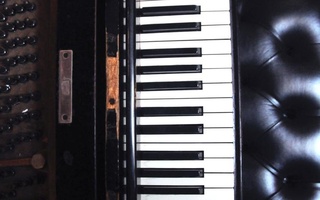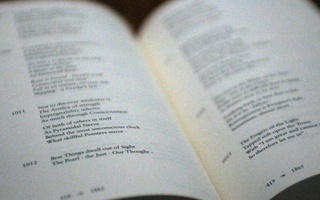Watsky’s exposure to both the cultures of slam competitions and rap battles has also reinforced his belief that the slam community is designed for mutual support far more than bitter rivalries. “You use poetic devices in rap battles, but it’s a totally different vibe…. You are directly opposing someone else, and your goal is to tear them down,” he says. “In spoken word, your piece is not about how everybody else is whack and sucks…. A poetry slam is like finger snaps and hippie love. The stereotypes start with a grain of truth.” The very reputation of slam, in Watsky’s mind, evokes Woodstock-like images of communal bliss––if slam poetry were to veer too heavily into strategy and machination, it would lose its identity.
{shortcode-03b106aea5995c0c3a4344d896e0fa1b5820213a}
CONFINES OF CUPSI
“I think all slam poets kind of hate slam poetry,” SOL board member Virginia R. Marshall ‘15, an active Crimson Arts editor, says ponderously. Although minor variations to the slam form crop up from competition to competition, the basic system is the same for almost all events, including CUPSI: three to five random judges, who don’t necessarily know anything about spoken word, are picked out of the audience to judge the event, which has a set number of pre-determined poets. The judges, who may given a somewhat nebulous rubric (five points for content, five points for presentation, for example), grade each artist’s up to three-minute performance on a 10-point scale. A number of rounds follow, after which the highest and lowest scores for each poet are usually dropped. At the end of the night, those who have the highest average scores win the event.
Marshall’s issues with the system concern how much the psychology of the audience impacts the program. “In the psychology of a slam, what’s most interesting is that it actually does matter what order you go in,” Marshall says. “Warming up an audience is extremely essential.”
To help with the process, many slams employ so-called “sacrificial poets,” who go first and act as calibrators of judge’s tastes and scoring proclivities. In addition to giving official competitors a chance to know the judges and adjust their impending programs accordingly, the “sacrificial poets” system helps to combat the phenomenon of “score creep”: the tendency of judges to grade poets more liberally as they event progresses. But Marshall is quick to stress that the system is flawed. “Sacrificial poets are meant to bring the scores up by the time you get to the first competitor, but it never really works…. Inevitably, people get warmed up to the experience of hearing poetry and will grade successive poets higher,” Marshall says.
Marshall says that she takes solace in the fact that Speak Out Loud has the humor and self-awareness to turn the judge-pleaser tropes inside out and create “meta” explorations of poetic stereotypes and pandering. “We really try to challenge the perceptions about what a spoken word poem is supposed to be,” Marshall says, smiling with a hint of mischief. “There’s a lot of manipulation of emotion that goes on in slam poetry.”
In addition to the “shock poem”archetype, Marshall outlined other slam poem archetypes that SOL attempts to subvert, including the funny referential poem, which she says often includes repeated allusions to late-1990s Nickelodeon cartoons. If Marshall, who emanates optimism, has an archetype, she says it’s the “happy poem,” which was harder to sell to audiences early on in her tumultuous slam journey. “I accidentally signed up for a slam not knowing what it was…. My first slam was a terrifying experience where I got incredibly low scores and lost. I was shocked but also a little bit exhilarated,” she says.
Marshall’s willingness to stick with the construct has led her from traumatized early dabblings to a place on Harvard’s CUPSI team. One of new poems is “( ),” a group piece that plays extensively with form and function, and suggests that slam archetypes are meant to be broken. By being conscious of the limitations of sensationalism and actively working to avoid slam poetry clichés, Marshall has managed to channel her distaste for the competitive aspects of slam into artistic innovation.
SLAM AS SPORT
Where Marshall deals with scoring by reveling in SOL’s propensity for irreverence and self-commentary, Bex H. Kwan ’14 embraces the raw competition of slam. “I’m the kind of person who makes little competitions for myself when I’m bored,” Kwan said. “I used to play competitive sports a lot.”
Kwan is aware of the what many perceive as an ideological conflict between art and sport but believes that slam is the closest thing to a combination between the two disciplines. Kwan, who speaks with a magnetic cerebrality and poeticism, suddenly quotes Robert Frost: “‘Writing free verse is like playing tennis with the net down.’”
Kwan’s borrowed simile suggests that the creation of poetry tailored towards competition still allows poets a considerable amount of freedom. Kwan confesses to feeling a modicum of frustration about the intricate rules of slam poetry but also believes, similarly to Euphrat Weston, that the nitpicky nature of competition pushes the art to the next level. “If I could change the form easily, then it wouldn’t challenge me as much,” Kwan said.
Read more in Arts
Chaos and HarmonyRecommended Articles
-
Komunyakaa Creates Bizarre, Beautiful World in ‘Couch’Some poets perform an act of creation that supersedes the poem as a mere vessel for thought or emotion. Instead, ...
-
 On Poetry
On Poetry -
Barker Center Hosts National Latino/a Poetry Now EventCorral and fellow poets Rosa Alcalá and Aracelis Girmay were the featured speakers at the inaugural Latino/a Poetry Now event held Tuesday night at the Barker Center.
-
 Harvard Poets Celebrated for Arts First
Harvard Poets Celebrated for Arts First -
Poetasters and Poet-Masters: Slam Night at the Cantab LoungeLast Wednesday at the Cantab Lounge’s weekly poetry slam open mic, no one snapped and hardly anyone wore black.
-
Poetry Reading at Houghton to Focus on EcologyThe nearly 600-page collection features formally innovative work in the tradition of the pastoral, an ancient form of lyric poetry celebrating shepherds and rural life. At the same time, these poems address ideas from an ecology perspective.













